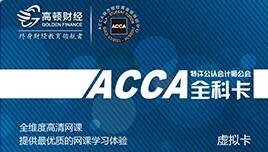高顿名师解析2013年ACCA考试F7/P2知识点2
How comes IFRS9?
- Relevant to paper F7/P2
As one of its important projects, IASB have being working on IFRS9 since the year of 2005. Although not completed, the project towards replacing IAS39 with IFRS9 has got several achievements. This article addresses the background of the project and its achievements up to Dec 2011.
Background
In April 2001 the International Accounting Standards Board (IASB) adopted IAS 39 Financial Instruments: Recognition and Measurement, which had originally been issued by the International Accounting Standards Committee in March 1999.
IAS 39 Financial Instruments: Recognition and Measurement sets out the requirements for recognising and measuring financial assets, financial liabilities and some contracts to buy or sell non-financial items. Many users of financial statements and other interested parties told the Board that the requirements in IAS 39 were difficult to understand, apply and interpret. They urged the Board to develop a new standard for the financial reporting of financial instruments that was principle-based and less complex. Although the Board amended IAS 39 several times to clarify requirements, add guidance and eliminate internal inconsistencies, it had not previously undertaken a fundamental reconsideration of reporting for financial instruments.
In 2005 the Board and the US Financial Accounting Standards Board (FASB) began working towards a long-term objective to improve and simplify the reporting for financial instruments. This work resulted in the publication of a discussion paper, Reducing Complexity in Reporting Financial Instruments, in March 2008. Focusing on the measurement of financial instruments and hedge accounting, the paper identified several possible approaches for improving and simplifying the accounting for financial instruments. The responses to the paper indicated support for a significant change in the requirements for reporting financial instruments. In November 2008 the Board added this project to its active agenda, and in December 2008 the FASB also added the project to its agenda.
The Board’s approach to replacing IAS 39
The Board intends that IFRS 9 will ultimately replace IAS 39 in its entirety. However, in response to requests from interested parties that the accounting for financial instruments should be improved quickly, the Board divided its project to replace IAS 39 into three main phases. As the Board completes each phase, it will delete the relevant portions of IAS 39 and create chapters in IFRS 9 that replace the requirements in IAS 39.
In April 2009, in response to the input received on its work responding to the financial crisis, and following the conclusions of the G20 leaders and the recommendations of international bodies such as the Financial Stability Board, the Board announced an accelerated timetable for replacing IAS 39.
The three main phases of the Board’s project to replace IAS 39 are:
(a) Phase 1: Classification and measurement of financial assets and financial liabilities.
As a result of the accelerated timetable for replacing IAS39, in July 2009 the Board published an exposure draft Financial Instruments: Classification and Measurement, followed by the first chapters of IFRS 9 Financial Instruments in November 2009. The first chapters of IFRS 9 relate to the classification and measurement of financial assets. Those chapters require all financial assets to be classified on the basis of the entity’s business model for managing the financial assets and the contractual cash flow characteristics of the financial asset. Assets are initially measured at fair value plus, in the case of a financial asset not at fair value through profit or loss, particular transaction costs. Assets are subsequently measured at amortised cost or fair value.
In October 2010 the Board added to IFRS 9 the requirements related to the classification and measurement of financial liabilities. This includes requirements on embedded derivatives and how to account for own credit risks for financial liabilities that are measured at fair value.
Most of the requirements in IAS 39 for classification and measurement of financial liabilities were carried forward unchanged to IFRS 9. Under IAS 39 most liabilities were subsequently measured at amortised cost or bifurcated into a host, which is measured at amortised cost, and an embedded derivative, which is measured at fair value. Liabilities that are held for trading (including all derivative liabilities) were measured at fair value. Although the Board had originally proposed a symmetrical approach for financial assets and financial liabilities in the exposure draft published in 2009, the Board decided to retain most of the requirements in IAS 39 for classifying and measuring financial liabilities because constituents told the Board that those requirements were working well in practice. Consistently with its objective to replace IAS 39 in its entirety, the Board relocated those requirements from IAS 39 to IFRS 9.
Consistently with the requirements in IFRS 9 for investments in equity instruments that do not have a quoted price in an active market for an identical instrument (ie a Level 1 input) (and derivative assets linked to those investments), the exception from fair value measurement was eliminated for derivative liabilities that are linked to and must be settled by delivery of such an equity instrument. Under IAS 39, if those derivatives were not reliably measurable, they were required to be measured at cost. IFRS 9 requires them to be measured at fair value.
The requirements related to the fair value option for financial liabilities were changed to address own credit risk. Those improvements respond to consistent feedback from users of financial statements and others that the effects of changes in a liability’s credit risk ought not to affect profit or loss unless the liability is held for trading. The improvements followed from the proposals published in May 2010 in the exposure draft Fair Value Option for Financial Liabilities.
(b) Phase 2: Impairment methodology.
In June 2009 the Board published a Request for Information on the feasibility of an expected loss model for the impairment of financial assets. This formed the basis of an exposure draft, Financial Instruments: Amortised Cost and Impairment, published in November 2009. The Board also set up a panel of credit and risk experts to consider and advise on the operational issues arising from an expected cash flow approach. The Board is redeliberating the proposals in the exposure draft to address the comments received from respondents, and suggestions from the expert advisory panel and other outreach activities.
(c) Phase 3: Hedge accounting.
The Board is considering how to improve and simplify the hedge accounting requirements of IAS 39. It expects to publish proposals for a comprehensive new approach before the end of 2010.
International comparability in the accounting for financial instruments
The Board and the FASB are committed to achieving increased comparability internationally in the accounting for financial instruments. However, those efforts have been complicated by the differing project timetables established to respond to the respective stakeholder groups. In May 2010 the FASB published a proposed Accounting Standards Update (ASU) on accounting for financial instruments that contained proposals for a new comprehensive standard on financial instruments, including proposals on the classification and measurement of financial assets and financial liabilities, impairment methodology and hedge accounting. The proposed ASU had a comment deadline of 30 September 2010 and the FASB has begun to redeliberate its proposals. The Board asked its constituents to provide feedback to the FASB on the proposals in the FASB’s exposure draft because this is a joint project with an objective of increasing international comparability. Feedback from IFRS constituents will be helpful to the FASB as it redeliberates its proposals. Moreover, after the FASB redeliberates its proposals, the Board will use that feedback to consider what steps (if any) should be taken to reconcile any remaining differences between IFRSs and US GAAP. Any possible changes as a result of that comparison will be subject to the Board’s normal due process.
Mandatory Effective Date of IFRS 9 and Transition Disclosures
Mandatory Effective Date of IFRS 9 and Transition Disclosures (Amendments to IFRS 9 (2009), IFRS 9 (2010) and IFRS 7), issued in December 2011, amended the effective date of IFRS 9 (2009) and IFRS 9 (2010) so that IFRS 9 is required to be applied for annual periods beginning on or after 1 January 2015. Early application is permitted. The amendments also modified the relief from restating prior periods. The Board has published amendments to IFRS 7 to require additional disclosures on transition from IAS 39 to IFRS 9.
Entities that initially apply IFRS 9 in periods:
(a) beginning before 1 January 2012 need not restate prior periods and are not required to provide the disclosures set out in paragraphs 44S–44W of IFRS 7;
(b) beginning on or after 1 January 2012 and before 1 January 2013 must elect either to provide the disclosures set out in paragraphs 44S–44W of IFRS 7 or to restate prior periods; and
(c) beginning on or after 1 January 2013 shall provide the disclosures set out in paragraphs 44S–44W of IFRS 7. The entity need not restate prior periods.
Prepared by Golden ACCA R&D Center
December, 2012

相关阅读
高顿名师解析2013年ACCA考试F5业绩管理知识点32013/02/18
高顿名师解析2013年ACCA考试F5业绩管理知识点22013/02/18
高顿名师解析2013年ACCA考试F5业绩管理知识点2013/02/18

















